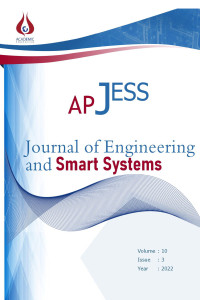Unsupervised Learning Approach for Detection and Localization of Structural Damage using Output-only Measurements
Abstract
Interrogation of the vibration data collected from the sensors embedded throughout the structure without relying on a finite element model of the system for monitoring the health of structural systems has received significant attention in the recent years especially with the current advancements in sensor technology. The data-driven methods explored within this context falls into the realm of statistical pattern recognition field requiring extraction of damage detection features and a statistical decision-making process for identification of damage. Machine learning algorithms provide statistical means for making such decisions. In this study, an unsupervised machine learning approach, one-class support vector machine (OC-SVM), requiring training data only from the undamaged state of the structure is explored for damage detection purposes. The coefficients of the autoregressive (AR) model are extracted as damage sensitive features and used as the required training data. The trained classifier is then used with the data obtained from the same structure at different damage states for classification. Damage detection in the form of recognizing outliers or anomalies not belonging to the target class, is followed by damage localization within the given sensor resolution using statistical means. Numerical simulations are performed on a truss and a beam structure with several damage scenarios illustrating the capabilities and the limitations of the proposed approach.
Keywords
structural health monitoring unsupervised learning support vector machines time series modelling statistical pattern recognition
References
- Barthorpe, R. J. (2010). On model-and data-based approaches to structural health monitoring (Doctoral dissertation), University of Sheffield.
- Rytter, A. (1993) Vibrational based inspection of civil engineering structures, University of Aalborg, 1993.
- Gul, M., & Catbas, F. N. (2011). Damage assessment with ambient vibration data using a novel time series analysis methodology. Journal of Structural Engineering, 137(12), 1518-1526.
- Flah, M., Nunez, I., Ben Chaabene, W., & Nehdi, M. L. (2021). Machine learning algorithms in civil structural health monitoring: a systematic review. Archives of computational methods in engineering, 28(4), 2621-2643.
- Wandji, J. N. (1998). A nonparametric goodness-of-fit test for a class of parametric autoregressive models. Journal of statistical planning and inference, 71(1-2), 57-74.
- Worden, K., Manson, G., & Fieller, N. R. (2000). Damage detection using outlier analysis. Journal of Sound and vibration, 229(3), 647-667.Itakura, F. (1975). Minimum prediction residual principle applied to speech recognition. IEEE Transactions on acoustics, speech, and signal processing, 23(1), 67-72.,
- Kar, C., & Mohanty, A. R. (2006). Monitoring gear vibrations through motor current signature analysis and wavelet transform. Mechanical systems and signal processing, 20(1), 158-187.
- Mattson, S. G., & Pandit, S. M. (2006). Statistical moments of autoregressive model residuals for damage localisation. Mechanical Systems and Signal Processing, 20(3), 627-645.
- Itakura, F. (1975). Minimum prediction residual principle applied to speech recognition. IEEE Transactions on acoustics, speech, and signal processing, 23(1), 67-72.
- Box, G. E., Jenkins, G. M., Reinsel, G. C. (1994). Time series analysis: Forecasting and control, Prentice-Hall, Upper Saddle River, NJ.
- Ljung, L. (1999). System identification: Theory for the user, Prentice-Hall, Upper Saddle River, NJ.
- Schölkopf, B., Williamson, R. C., Smola, A., Shawe-Taylor, J., & Platt, J. (1999). Support vector method for novelty detection. Advances in neural information processing systems, 12, 582–588.
- Schölkopf, B., Smola, A. J., & Bach, F. (2002). Learning with kernels: support vector machines, regularization, optimization, and beyond. MIT press.
Abstract
References
- Barthorpe, R. J. (2010). On model-and data-based approaches to structural health monitoring (Doctoral dissertation), University of Sheffield.
- Rytter, A. (1993) Vibrational based inspection of civil engineering structures, University of Aalborg, 1993.
- Gul, M., & Catbas, F. N. (2011). Damage assessment with ambient vibration data using a novel time series analysis methodology. Journal of Structural Engineering, 137(12), 1518-1526.
- Flah, M., Nunez, I., Ben Chaabene, W., & Nehdi, M. L. (2021). Machine learning algorithms in civil structural health monitoring: a systematic review. Archives of computational methods in engineering, 28(4), 2621-2643.
- Wandji, J. N. (1998). A nonparametric goodness-of-fit test for a class of parametric autoregressive models. Journal of statistical planning and inference, 71(1-2), 57-74.
- Worden, K., Manson, G., & Fieller, N. R. (2000). Damage detection using outlier analysis. Journal of Sound and vibration, 229(3), 647-667.Itakura, F. (1975). Minimum prediction residual principle applied to speech recognition. IEEE Transactions on acoustics, speech, and signal processing, 23(1), 67-72.,
- Kar, C., & Mohanty, A. R. (2006). Monitoring gear vibrations through motor current signature analysis and wavelet transform. Mechanical systems and signal processing, 20(1), 158-187.
- Mattson, S. G., & Pandit, S. M. (2006). Statistical moments of autoregressive model residuals for damage localisation. Mechanical Systems and Signal Processing, 20(3), 627-645.
- Itakura, F. (1975). Minimum prediction residual principle applied to speech recognition. IEEE Transactions on acoustics, speech, and signal processing, 23(1), 67-72.
- Box, G. E., Jenkins, G. M., Reinsel, G. C. (1994). Time series analysis: Forecasting and control, Prentice-Hall, Upper Saddle River, NJ.
- Ljung, L. (1999). System identification: Theory for the user, Prentice-Hall, Upper Saddle River, NJ.
- Schölkopf, B., Williamson, R. C., Smola, A., Shawe-Taylor, J., & Platt, J. (1999). Support vector method for novelty detection. Advances in neural information processing systems, 12, 582–588.
- Schölkopf, B., Smola, A. J., & Bach, F. (2002). Learning with kernels: support vector machines, regularization, optimization, and beyond. MIT press.
Details
| Primary Language | English |
|---|---|
| Subjects | Software Engineering (Other) |
| Journal Section | Research Articles |
| Authors | |
| Early Pub Date | September 16, 2022 |
| Publication Date | September 30, 2022 |
| Submission Date | April 7, 2022 |
| Published in Issue | Year 2022 Volume: 10 Issue: 3 |
Cited By
Frequency data driven damage detection of polymeric composite structural health using machine learning models
ZAMM - Journal of Applied Mathematics and Mechanics / Zeitschrift für Angewandte Mathematik und Mechanik
https://doi.org/10.1002/zamm.202400481
Academic Platform Journal of Engineering and Smart Systems


